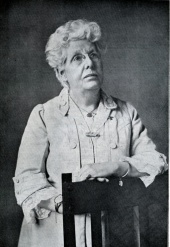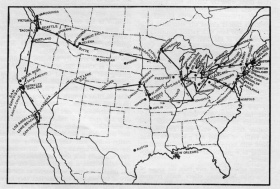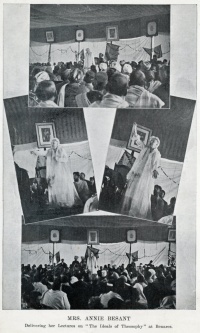Besant lectures
Annie Besant, social activist and President of the Theosophical Society, was considered to be one of the great orators of her day.
Lecture tours for the Theosophical Society
NOTE: THIS SECTION IS UNDER CONSTRUCTION
NOTE: THIS SECTION IS UNDER CONSTRUCTION
Arundale's account of her oratory
In his introduction to The Besant Spirit, George S. Arundale wrote of Dr. Besant's activities in the Indian independence movement. Each evening at 5:30, she would visit the Young Men's Indian Association building to have a cup of coffee, and to attend meetings at Gokhale Hall:
The Hall packed to the brim with youth and a sprinkling of the older generation sedately seated on the platform. Enters the white-robed figure of the Editor of New India, almost gorgeously arrayed in silken sari, with an H. R. pendant in green and gold enamel – green and gold being the then Home Rule colours. An entourage of those who were to be the principal speakers – and the chairman, if she was not herself to take the chair, as she so often did. A torrent of applause. A cheery smile if she was not too engrossed in deep conversation with her colleagues. Wave upon wave of cheers. A bow to the audience with folded hands. A rustle of chairs and a general fussification as the entourage settled itself down. And then a Hall-wide hush of expectancy, with everybody impatient to hear the world's greatest orator demand freedom for India in language that no one could possibly mistake.
If Dr. Besant were the chairman she would make a few, very brief, opening remarks, absolutely to the point, and with all that graciousness which she alone had, and which she used with such perfect tact to make everybody, and specially to those who had to speak before her, feel entirely at home. No small ordeal was it to speak in her presence, for not only did it seem so futile to keep an audience waiting with one's halting remarks when every member of the audience had come to hear one person and one person only, but what was worse one knew full well that the audience was impatient to get one over and out of the way. Woe betide any speaker who at all trespassed upon the endurance of the audience! He or she would soon receive vocal evidence of the fact that a word more and there would be a shouting down. And then, when the last speaker had exerted his voice upon ears that were growing more and more deaf if they were not already so, then – Annie Besant. Quietly rising from her chair she would stand silent for a few moments while the audience gave vent to its relief that at last she was to be heard, a little bow of acknowledgment, the hands folded, or one hand resting, perhaps, on the adjoining table, a few tiny pages of notes on occasion, and then a still small voice which just for a moment could hardly be heard beyond the first few rows in front of her. An eager craning of heads beyond and from the gallery. But the crescendo was at work, and soon wave upon wave of scintillating oratory swept through the Hall – with all the rich jewels of oratory adorning sentence after sentence, period after period. A climax is reached, perhaps a magnificent simile, so complicated as it seemed that I would wonder how it could ever be resolved. Would she remember the whole thread of it from its inception? Must it not break down through sheer complexity? Sometimes, I confess, I was in an agony of nervousness. How foolish I was! Did she at any time lose the thread? Was she ever at a loss either for a word or how to finish a simile, a metaphor, however involved? Never, and I have heard her constantly for over thirty years.
And from the climax, from the splendid finale to a simile, she would proceed to a new motif – the old perfectly rounded off and fitted into the word picture she was painting. From the heights of a consummation, with a voice ringing through vast distances and yet so perfectly modulated that she seemed but to be speaking in just a conversational voice, she would descend to the foundations of a new word structure – yet another part of the plan which was in her mind, and in her consciousness above the mind, in all its details. Then the building once more, and a new delight for the audience to see with their very eyes, and to hear with their very ears, the master craftsman at work. True indeed that the ears were not alone the medium of communication between the audience and the speaker. The eyes saw, and the sight added immensely to the sounds that were heard. It was as necessary to look at her as to hear her, for the sight of her was an inspiration, and her movements, whether of body as a whole or of her arms, were an education by themselves in that grace which must ever accompany all true oratory. I think I have come to know her gestures by heart. I think I was able to anticipate each one as it came, even though she had no set gestures, ringing innumerable and different changes on the gesture accompaniment as she developed theme after theme. But somehow one became able to see beforehand as in a film thrown upon a screen the whole picture of her immediate utterances – a picture all the more wonderful in that, kaleidoscope-like, it was ever changing and one wondered which particular variation on the essential theme she would finally choose as she came to it. Dr. Besant has herself said more than once that as she spoke she saw before her the immediate continuation of her speech, not in set sentences but in a choice of sentences, out of which she would while speaking, choose the particular phraseology most suitable to the development of her general theme. Those very near to her in thought and in work would sometimes catch a glimpse of the wealth of alternatives before her, and almost see her choosing.[1]
Lectures available in print
See also Besant writings, as some lecture transcriptions may appear in print in mixed collections of articles and lectures.
Lectures from International TS Conventions
Mrs. Besant's convention lectures were generally available as pamphlets through the various branches of the Theosophical Publishing House and outlets such as the Theosophical Book Concern.[2]
- 1893 - "The Building of the Kosmos".
- 1894 - "The Self and Its Sheaths".
- 1896 - "Four Great Religions".
- 1900 - "Ancient Ideals in Modern Life".
- 1912 - "Theosophy and the Theosophical Society".
- 1914 - "Theosophy in Relation to Human Life".
- 1915 - "Theosophy and Life's Deeper Problems".
- 1917 - "Duties of the Theosophist: Being Three Convention Lectures Delivered in Lucknow at the Forty-First Anniversary of the Theosophical Society, December, 1916."
Lectures printed in pamphlets and collections
- Australian lectures, 1908. Sydney, Robertson, 1908. Available at Hathitrust.
- Avatâras: Four Lectures Delivered at the Twenty-fourth Anniversary Meeting of the Theosophical Society at Adyar, Madras, December, 1899. London: Theosophical Publishing Society, 1900.
- Buddhist Popular Lectures.
- The Changing World. London: The Theosophical Publishing Society, 1910. Also available at Gutenberg and Forgotten Books. Fifteen Lectures delivered in London during May, June, and July 1909. It was reprinted many times, and issued in a shorter version as The Immediate Future. Reviewed briefly in The Messenger, July 1919, page 63.
- Education as the Basis of National Life. Adyar, Madras: The Theosophist Office, Delivered at Adyar, in The Theosophical Hall, February 23, 1908. (Second edition).
- Electricity. Published by Annie Besant and Charles Bradlaugh. Four lectures. Very rare - copies at Harvard, York Universities.
- Esoteric Christianity; or, The Lesser Mysteries. London: Theosophical Publishing Society, [1898?] a series of public lectures delivered on Sundays in July, 1898 at the Queen's Hall in London. Pamphlet. Available at Hathitrust. 2nd edition. London: Theosophical Pub. Society, 1905. Available at Hathitrust.
- Essays and Addresses. India. London, Theosophical Publishing Society, 1913. Available from Hathitrust.
- Five Sermonettes. Adyar, Madras, India: Theosophical Publishing House, 1929. Delivered by Annie Besant in the Liberal Catholic Church in Huizen, Holland, July 12-16, 1927.
- Four Great Religions, Four Lectures Delivered on the Twenty-first Anniversary of the Theosophical Society at Adyar, Madras. Benares and London, Theosophical Pub. Society, 1897.
- The Guardians of Humanity. Adyar, Madras, India: Theosophist Office, 1908. Delivered in the Theosophical Hall, Adyar, on March 8, 1908. Adyar popular lectures; no. 6.
- Is Theosophy Anti-Christian? London: Theosophical Publishing Society, 1904 and Chicago: Rajput Press, 1904. Reprinted in 1918 and 1929. Subtitled "an explanation addressed to the Bishop of London, [a lecture] delivered on July 1st, 1904."
- Jainism. Adyar, India: Theosophical Pub. House, 1949, 1997. Reprint of a Convention Lecture delivered in 1901 at Adyar, on the 26th anniversary of the Theosophical Society. Searchable at Hathitrust.
- Lectures on Political Science. Adyar, Madras, India: The Society for the Promotion of National Education, 1919. Seven lectures delivers in the national College of Commerce, madras, to First Year Students, issued as an elementary text book on political science. "A second series is intended to follow the this first." Topics included The State, The Evolution of the State, The East, The West, and Government.
- The Masters as Facts and Ideals. London: Theosophical Publishing Society, 1895. Originally given as a lecture in St. James's Hall, April 27th, 1895.
- Messages 1913-1931. Adyar, Madras, India: Theosophical Publishing House, 1931.
- Problems of Reconstruction: Lectures delivered at the forty-third Anniversary Meeting of the Theosophical Society at Delhi, December, 1918. Adyar, Madras, India: Theosophical Publishing House, 1919.Four lectures: Religious Reconstruction, Social Reconstruction, Political Reconstruction, Educational Reconstruction.
- Some Problems of Life. London, Theosophical publishing society,1900. Available at Hathitrust.
- The Progress of the Theosophical Society. Adyar, Madras, India: Theosophical Publishing House, 1925. "The Presidential Address of Annie Besant, D.L., P.T.S. to the Forty-ninth Annual Convention."
- Speeches & Writings of Annie Besant. Madras, India: G.A. Natesan & Co., 1921. "A thoroughly revised and enlarged edition of 'For India's uplift'." [Third edition] Available at Hathitrust and Google Books.
- The Sphinx of Theosophy: A Lecture. London: Theosophical Publishing House, [between 1890-1899?].
- The Story of the Great War, Some Lessons from the Mahābhārata for the Use of Hindū students in the Schools of India. Adyar, Madras, India: Theosophical Publishing House, 1919. "From notes of lectures originally delivered at the Central Hindu college, Benares." 2nd edition available at Hathitrust.
- Study and Practice. London: Issued by the Blavatsky Lodge of the Theosophical Society, [1919] A lecture delivered by Mrs. Besant at Mortimer Hall, under the auspices of Blavatsky Lodge of the T.S. in England and Wales on October 3rd, 1919.
- The Theosophical Student in Face of Revelation, Inspiration, and Observation: A Lecture Delivered at the British Convention of the Theosophical Society, July 4th 1909. London: Theosophical Publishing House, 1948. Published for the Theosophical Research Centre.
- Theosophy and the New Psychology: A Course of Six Lectures. London: Theosophical Pub. Society; New York: John Lane; Chicago: Theosophical Book Concern, 1904. Available at Hathitrust and AnandGholap.net.
- The Three Paths to Union with God; Lectures Delivered at Benares, at the Sixth Annual Convention of the Indian Section of the Theosophical Society, October 19th, 20th and 21st, 1896. London, Theosophical Pub. Society [1910?] Reprinted 1913. Available at Hathitrust.
- The Universal Law of Life: Two Addresses by Annie Besant Given at the World Parliament of Religions, September 1893. Adyar, Madras, India: Theosophical Publishing House, 1992. 42 pages.
- The War and Its Lessons: Four Lectures Delivered in London, October, 1919. London: Theosophical Publishing House, 1920. Available at Hathitrust.


